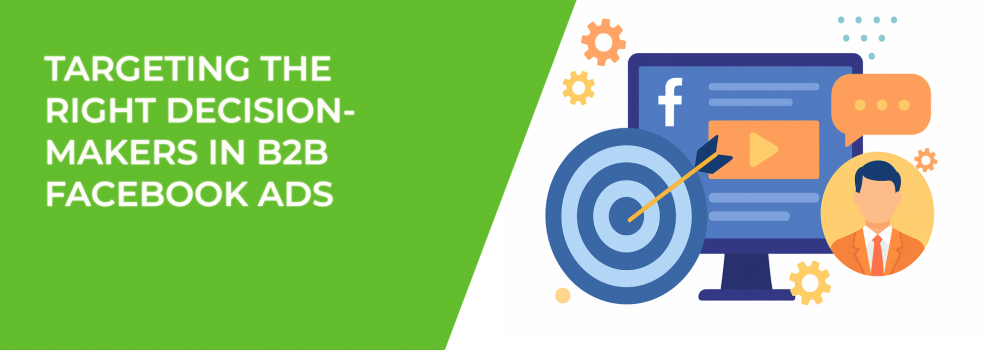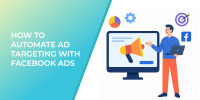Reaching the right people is half the battle in B2B marketing. The other half? Making sure they actually make the decisions.
If you're running B2B Facebook ads and your message lands in front of the wrong person — someone who can’t say yes, sign a contract, or move a deal forward — you're wasting ad spend. You’re lighting money on fire.
So, how do you zero in on the people who matter?
Let’s unpack how to sharpen your Facebook ad targeting so your budget works harder, and your ads work smarter.
Why Decision-Makers Matter So Much in B2B Ads
In B2C, the user is usually the buyer. Simple. But B2B is a different animal.
You’re often dealing with:
-
Long sales cycles,
-
Complex solutions,
-
Internal politics, and
-
Multi-level buying committees.
There’s rarely a single buyer. There are influencers, blockers, gatekeepers — and, if you’re lucky, someone who can sign the dotted line.
You don’t want to pitch an enterprise SaaS platform to a junior analyst who can’t even approve a Zoom subscription. You want the Director of IT. The VP of Procurement. The founder or the department head — the person who sees the big picture and owns the decision.
These people:
-
Control budgets;
-
Drive strategy;
-
Sign contracts; and
-
Influence other stakeholders.
If your ads aren’t reaching them, you’re setting yourself up for shallow engagement and dead-end leads.
So how do you find them?
Start With Intent, Not Just Demographics
Facebook’s native targeting lets you filter by interests, job titles, employer, and more. It’s powerful — but it’s also superficial. In B2B, relying only on profile data is risky.
Job titles lie. A “Head of Growth” at one company might be a 2-person team. At another, it's an executive with P&L responsibility and hiring power. Context matters.
That’s why behavioral signals — the what people do, not just what they say about themselves — are a far more reliable foundation for targeting.
Facebook groups and pages can be a great channel for finding B2B customers and leads.
Look for engagement patterns that signal professional interest and intent, like:
-
Participating in niche Facebook groups related to your industry;
-
Commenting on or sharing B2B-related posts and thought leadership content;
-
Following and interacting with company pages, software vendors, or vertical-specific influencers.
These are digital breadcrumbs. Because people who engage with professional content are more likely to be in the decision-making process. Or, at the very least, close to it.
And guess what? You can target them precisely.
Leverage Custom Audiences That Go Deeper
This is where LeadEnforce steps in and makes a big difference.
Instead of trying to reverse-engineer your target audience using Facebook’s broad interest categories, LeadEnforce allows you to build custom audiences from actual users of:
-
Specific Facebook groups,
-
Facebook pages, and
-
Instagram accounts.
This gives you the ability to reach real, living, active professionals inside digital communities where your solution is already being discussed, explored, or implemented.
Here are some examples:
-
Want to reach HR leaders? Build a custom audience from users active in HR-focused communities like remote hiring, payroll systems, or culture building.
-
Selling software to digital agencies? Target those participating in freelancer and agency growth groups — people talking about client retention, scaling, and automation.
-
Offering a B2B analytics platform? Go after followers and commenters on competitor Instagram profiles or data strategy content hubs.
This targeting method helps you bypass the guesswork and reach professionals who are already immersed in relevant conversations.
Want a step-by-step walkthrough? Here’s how to build your target audience from a Facebook group.
Look Beyond Titles — Use Layered Targeting
LeadEnforce gets you in front of the right community. But you can get even sharper by adding layers with Facebook’s built-in tools.
Once you've imported your custom audience, refine it by combining behavioral targeting with demographic or contextual filters like:
-
Job seniority — Filter for executives, founders, VPs, or directors. These roles are more likely to make or influence purchases.
-
Education or field of study — Especially useful for technical products or services.
-
Company size or industry — Selling to mid-market SaaS companies? Don’t waste impressions on enterprise giants.
-
Device usage — Want to reach B2B professionals in work mode? Focus on desktop users.
This layered approach reduces waste and increases relevance. You're stacking signals — interest, activity, role, and context — to create a high-fidelity audience.
If you're still refining the basics of who to reach and how to reach them, this Facebook Ad Targeting 101 guide breaks down foundational strategies you can layer on top of what you’ll learn here.
Craft Ads That Speak Their Language
Once you’ve captured the right audience, the next job is to earn their attention — and keep it.
Decision-makers don’t want vague promises. They want clarity, credibility, and confidence.
So give it to them. Your ad should immediately answer:
-
What problem you solve — Don’t bury it in buzzwords.
-
Why you’re different — What’s your angle? Speed? Cost savings? Simplicity?
-
Why they should care now — Time, urgency, or market shifts? Highlight them.
Use clear headlines, trust-building elements (like reviews or social proof), and CTAs that suggest action without pressure.
Examples:
-
“Automate 80% of Your Onboarding — Without Rewriting a Single SOP.”
-
“Trusted by 3,000+ B2B Sales Teams. Is Yours Next?”
-
“Book a 10-Minute Demo. We’ll Prove It’s Worth Your Time.”
And don’t forget: Facebook is still a scroll-heavy platform. Even a CMO is moving fast. So, make your ads visual, mobile-optimized, and instantly clear.
For a creative edge, these best practices for designing mobile-friendly Facebook ads can help your messaging stand out in the feed.
Test and Learn — Always
Even if you’ve built the perfect audience, tested creative, and launched your campaign — your job isn’t done.
The best-performing B2B advertisers treat Facebook like a lab. They’re constantly experimenting with:
-
Creative combinations — Static vs. video, testimonials vs. product shots;
-
Ad copy — Long-form vs. short-form, formal vs. conversational;
-
Call-to-action variations — “Learn More” vs. “Book a Demo” vs. “Download Guide”;
-
Offer positioning — Leading with ROI vs. leading with ease of use.
And they’re not just tracking clicks. They're monitoring:
-
Lead quality;
-
Booking rates;
-
Sales cycle velocity; and
-
Customer acquisition cost (CAC).
Facebook can be unpredictable. But your results don’t have to be. Keep iterating.
Final Thoughts: Quality Over Quantity
If you’ve ever been excited by 300 leads only to discover none of them had purchase authority — you already know this:
You don’t need more leads. You need better ones.
That’s why targeting decision-makers matters. That’s why behavior beats demographics. And that’s why tools like LeadEnforce are such a valuable part of your B2B marketing stack.
So take the time to go deeper with your targeting. Stack your signals. Layer your filters. Test your assumptions.
Because once you stop chasing the crowd and start connecting with real decision-makers, Facebook Ads go from noise to ROI.

